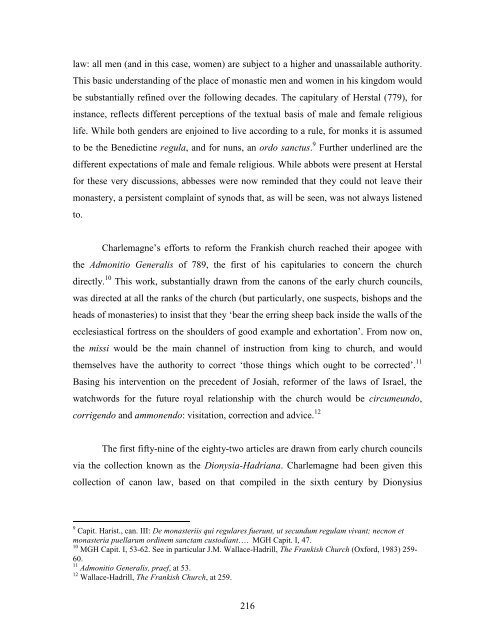Lindsay Rudge PhD Thesis - University of St Andrews
Lindsay Rudge PhD Thesis - University of St Andrews
Lindsay Rudge PhD Thesis - University of St Andrews
You also want an ePaper? Increase the reach of your titles
YUMPU automatically turns print PDFs into web optimized ePapers that Google loves.
law: all men (and in this case, women) are subject to a higher and unassailable authority.<br />
This basic understanding <strong>of</strong> the place <strong>of</strong> monastic men and women in his kingdom would<br />
be substantially refined over the following decades. The capitulary <strong>of</strong> Herstal (779), for<br />
instance, reflects different perceptions <strong>of</strong> the textual basis <strong>of</strong> male and female religious<br />
life. While both genders are enjoined to live according to a rule, for monks it is assumed<br />
to be the Benedictine regula, and for nuns, an ordo sanctus. 9 Further underlined are the<br />
different expectations <strong>of</strong> male and female religious. While abbots were present at Herstal<br />
for these very discussions, abbesses were now reminded that they could not leave their<br />
monastery, a persistent complaint <strong>of</strong> synods that, as will be seen, was not always listened<br />
to.<br />
Charlemagne’s efforts to reform the Frankish church reached their apogee with<br />
the Admonitio Generalis <strong>of</strong> 789, the first <strong>of</strong> his capitularies to concern the church<br />
directly. 10 This work, substantially drawn from the canons <strong>of</strong> the early church councils,<br />
was directed at all the ranks <strong>of</strong> the church (but particularly, one suspects, bishops and the<br />
heads <strong>of</strong> monasteries) to insist that they ‘bear the erring sheep back inside the walls <strong>of</strong> the<br />
ecclesiastical fortress on the shoulders <strong>of</strong> good example and exhortation’. From now on,<br />
the missi would be the main channel <strong>of</strong> instruction from king to church, and would<br />
themselves have the authority to correct ‘those things which ought to be corrected’. 11<br />
Basing his intervention on the precedent <strong>of</strong> Josiah, reformer <strong>of</strong> the laws <strong>of</strong> Israel, the<br />
watchwords for the future royal relationship with the church would be circumeundo,<br />
corrigendo and ammonendo: visitation, correction and advice. 12<br />
The first fifty-nine <strong>of</strong> the eighty-two articles are drawn from early church councils<br />
via the collection known as the Dionysia-Hadriana. Charlemagne had been given this<br />
collection <strong>of</strong> canon law, based on that compiled in the sixth century by Dionysius<br />
9<br />
Capit. Harist., can. III: De monasteriis qui regulares fuerunt, ut secundum regulam vivant; necnon et<br />
monasteria puellarum ordinem sanctam custodiant…. MGH Capit. I, 47.<br />
10<br />
MGH Capit. I, 53-62. See in particular J.M. Wallace-Hadrill, The Frankish Church (Oxford, 1983) 259-<br />
60.<br />
11<br />
Admonitio Generalis, praef, at 53.<br />
12<br />
Wallace-Hadrill, The Frankish Church, at 259.<br />
216

















